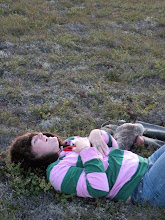Waqaa is the Yup'ik word meaning "hello," and Cama'i is the Yup'ik word meaning "welcome." However, Cama'i is bigger than that. It's also the three day native dance festival held in Bethel every year. Dance groups, native craft vendors, and people from all over the state come to share in a weekend of native dance and culture.
Most of the dance groups that perform are from the Bethel and the YK Delta. Yup'ik dance is pretty stationary; each dance tells a story, and the story is told by the rhythm of the drums, the singing, and arm movements. Men and women dance together, with men kneeling in front and women standing in back. The men and women all wear qaspeqs (native shirts), mukluks (fur boots), and use dance fans. The men's dance fans are made of feathers, and the women's are made of fur. The women also wear beautiful fur headresses. Usually, the qaspeqs are all different colors, making for a very colorful and vibrant stage. Add that to the thump of the drums and the chant of men's voices that constantly rolls underneath and you have a very evocative experience. It was a great way to experience Yup'ik culture.
We also got to experience some other cultures, including other Native Alaskan groups, Sudanese (GORGEOUS outfits), Japanese, and urban (a break-dancing group from Anchorage called Static Elementz. Note the "z"). It was a really cool weekend, even if it was a little overwhelming to have as many people as were there crammed into the Bethel Regional High School gym and lobby.
Another thing I really liked about Cama'i was being able to see a lot of my clients out and about. So often, I come into contact with my clients over the phone, in court, and in times of crisis. Seeing them at Cama'i gave me the opportunity to just "hang out" with a lot of them, which was a really nice gift.
Most of the dance groups that perform are from the Bethel and the YK Delta. Yup'ik dance is pretty stationary; each dance tells a story, and the story is told by the rhythm of the drums, the singing, and arm movements. Men and women dance together, with men kneeling in front and women standing in back. The men and women all wear qaspeqs (native shirts), mukluks (fur boots), and use dance fans. The men's dance fans are made of feathers, and the women's are made of fur. The women also wear beautiful fur headresses. Usually, the qaspeqs are all different colors, making for a very colorful and vibrant stage. Add that to the thump of the drums and the chant of men's voices that constantly rolls underneath and you have a very evocative experience. It was a great way to experience Yup'ik culture.
We also got to experience some other cultures, including other Native Alaskan groups, Sudanese (GORGEOUS outfits), Japanese, and urban (a break-dancing group from Anchorage called Static Elementz. Note the "z"). It was a really cool weekend, even if it was a little overwhelming to have as many people as were there crammed into the Bethel Regional High School gym and lobby.
Another thing I really liked about Cama'i was being able to see a lot of my clients out and about. So often, I come into contact with my clients over the phone, in court, and in times of crisis. Seeing them at Cama'i gave me the opportunity to just "hang out" with a lot of them, which was a really nice gift.
Lastly, I bought my first qaspeq at Cama'i! I'm so excited. It's lime green and I love it. And, as my clients from the jail told me at Therapeutic Court last week, it brings out my eyes. Nice.
Of course, some pictures! (Bear with me on the quality of these, I'm not good at being pushy enough to get all the way to the front.)




